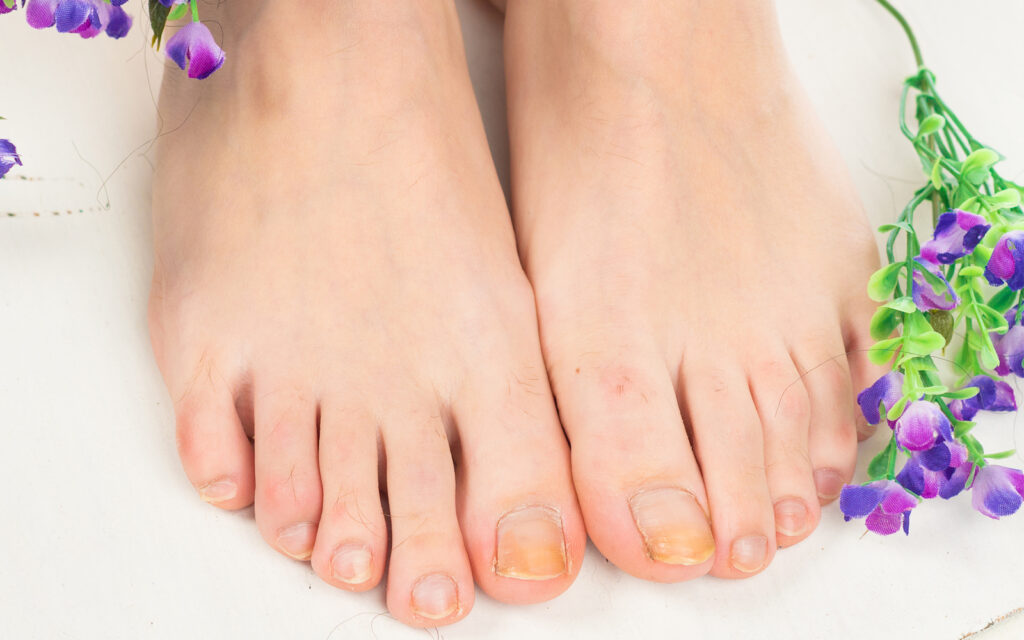Nail fungus, or onychomycosis, is a common condition that can progress from minor cosmetic issues to more serious discomfort if left untreated. Understanding the stages of nail fungus and recognizing early symptoms can help prevent severe infections. This article provides a comprehensive overview of the stages, symptoms, and available treatments for nail fungus.
Table of Contents
ToggleWhat is Nail Fungus?
Nail fungus, medically known as onychomycosis, is a fungal infection affecting the keratin that makes up your nails. It commonly starts as a white or yellow spot under the nail and can spread, leading to discoloration, thickening, and crumbling edges. Fungal infections are caused by dermatophytes, yeasts, or molds that thrive in warm, moist environments.
Stage 1: Early Symptoms of Nail Fungus
In the initial stage, the symptoms are subtle and easy to overlook. Early signs include:
- Discoloration: A white or yellow spot at the tip of the nail.
- Texture Changes: Slight roughness or brittleness.
- Mild Odor: A faint smell may emerge as the fungus starts to grow.
Early detection is crucial for preventing the progression of nail fungus. Over-the-counter antifungal treatments can often be effective at this stage.
Stage 2: Intermediate Stage of Nail Fungus
If untreated, nail fungus advances to the intermediate stage. Common symptoms include:
- Thickening of the Nail: Nails become visibly thicker and harder to trim.
- Increased Discoloration: The nail may turn yellow, brown, or gray.
- Crumbling Edges: Parts of the nail may chip or crumble.
At this stage, prescription treatments or clinical interventions, such as laser therapy, may be required for effective results.
Stage 3: Advanced Nail Fungus
Advanced nail fungus is more severe and can lead to pain and discomfort. Symptoms include:
- Severe Deformation: Nails may become misshapen and discolored.
- Detachment: The nail may separate from the nail bed, a condition known as onycholysis.
- Thickened Skin: The skin around the nail may thicken or become inflamed.
This stage often requires aggressive treatment, such as oral antifungal medications or surgical removal of the affected nail.

Risk Factors and Causes of Nail Fungus
Certain factors increase the likelihood of developing nail fungus:
- Age: Older adults are more susceptible due to slower nail growth and reduced circulation.
- Health Conditions: Diabetes, weakened immune systems, and circulatory issues increase risk.
- Environment: Walking barefoot in public places like pools and gyms creates exposure.
- Injury: Damaged nails are more vulnerable to fungal infections.
How to Prevent Nail Fungus
Prevention is key to avoiding the discomfort and complications of nail fungus. Follow these tips:
- Maintain Hygiene: Keep nails clean and dry.
- Trim Properly: Use sanitized tools and avoid cutting nails too short.
- Wear Breathable Footwear: Opt for shoes that allow air circulation.
- Avoid Sharing Personal Items: Do not share nail clippers, towels, or shoes.
- Use Antifungal Products: Apply powders or sprays in shoes if prone to sweating.
Treatment Options for Nail Fungus
There are several treatment options for nail fungus, depending on the severity:
Over-the-Counter Treatments
- Topical Antifungal Creams: Effective for mild infections.
- Antifungal Nail Lacquers: Help prevent the spread of fungus.
Prescription Medications
- Oral Antifungal Drugs: Such as terbinafine and itraconazole.
- Topical Prescription Treatments: More potent than OTC options.
Clinical Procedures
- Laser Therapy: Targets and kills fungal infections with precision.
- Surgical Removal: In severe cases, removing the nail can allow healthier growth.
Home Remedies
- Tea Tree Oil: Knownfor its antifungal properties.
- Apple Cider Vinegar: A natural remedy to reduce fungal growth.
Nail fungus is a manageable condition, but early detection and consistent treatment are essential for recovery. If you suspect an infection, consult a healthcare professional to determine the best course of action. For more tips and guidance, stay tuned to our blog!
FAQ
How do I know if I have nail fungus?
Early signs include discoloration and slight roughness on the nail’s surface. If you notice thickening, chipping, or a foul odor, consult a healthcare provider.
Can nail fungus go away on its own?
Nail fungus rarely resolves without treatment. Ignoring it can lead to worsening symptoms and complications.
What is the most effective treatment for nail fungus?
Oral antifungal medications are often the most effective, but early-stage infections can respond well to topical treatments.
How long does it take to treat nail fungus?
Treatment duration varies. Topical treatments may take several months, while oral medications can show results in a few weeks.
Is nail fungus contagious?
Yes, nail fungus can spread through direct contact or shared surfaces like towels, shoes, and public showers.
It is important for people considering skin tag removal in plano , laser hair removal in plano ,microneedling in plano, Hydrafacial in plano, Microdermabrasion plano, Laser electrolysis plano, Nail Fungus plano, Rosacea Treatment in plano, Spider Vein Removal plano, Wrinkle Reduction in plano, Botox in plano, Hifu in plano,Oxygeno Facial in Plano to undergo a full consultation with a qualified doctor or cosmetologist – Aesthetician Nasrin, – to assess their suitability for this procedure and discuss their .
No comment yet, add your voice below!